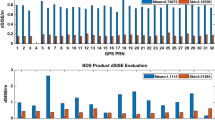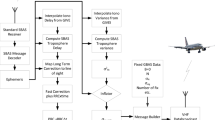Abstract
Different approaches have been developed to monitor the integrity of the Global Positioning System (GPS). The individual approaches rely on conservative error bounds and faces great challenges in meeting stringent integrity requirements set by the International Civil Aviation Organization (ICAO). These approaches, in fact, do not compete with one another but complement one another. We propose the vertical integration of the Satellite-Based Augmentation System (SBAS) and a local monitor station in this study. When the SBAS data deviate from the local monitor, users are informed to revert to the error bounds that are directly determined from SBAS data. Otherwise, the validation criterion that the error of the SBAS corrected solution is within a threshold is exploited to tighten the SBAS error bounds. The algorithm to integrate the SBAS with the independent monitor station is described, and its performance is evaluated based on simulations and real observations. The test results show that the vertical protection level (VPL) is reduced on average from 17.60 to 11.27 m, i.e., a 30.3% reduction in VPL while the integrity is guaranteed.










Similar content being viewed by others
References
Bang E, Lee J, Walter T, Lee J (2016) Preliminary availability assessment to support single-frequency SBAS development in the Korean region. GPS Solut 20(3):299–312
Blanch J, Walter T, Enge P, Stern A, Altshuler E (2014) Evaluation of a covariance-based clock and ephemeris error bounding algorithm for SBAS. In: Proceedings ION GNSS 2014, Institute of Navigation, Tampa, September 8–12, pp 3270–3276
Brown RG (1997) Solution of the two-failure GPS RAIM problem under worst case bias conditions: parity space approach. J Inst Navig 44(4):425–431
Cao Y, Zhou S, Hu X, Wu B, Zhou S, Liu L, Su R, Chang Z, He F, Zhou J (2012) The wide-area difference system for the regional satellite navigation system of COMPASS. Sci China Phys Mech Astron 55(7):1307–1315
Chen J, Huang Z, Li R (2017) Computation of satellite clock–ephemeris corrections using a priori knowledge for satellite-based augmentation system. GPS Solut 21(2):663–673
Choy S, Kuckartz J, Dempster AG, Rizos C, Higgins M (2017) GNSS satellite-based augmentation systems for Australia. GPS Solut 21(3):835–848
Comp C et al (1998) Demonstration of WAAS aircraft approach and landing in Alaska. In: Proceedings of ION GPS 1998, Institute of Navigation, Nashville, September 15–18, pp 177–184
Dautermann T, Felux M, Grosch A (2012) Approach service type D evaluation of the DLR GBAS testbed. GPS Solut 16(3):375–387
Lee J, Seo J, Park YS, Pullen S, Enge P (2011) Ionospheric threat mitigation by geometry screening in ground-based augmentation systems. J Aircr 48(4):1422–1433
Manabe H (2008) Status of MSAS: MTSAT satellite-based augmentation system. In: Proceedings of ION GNSS 2008, Institute of Navigation, Savannah, September 16–19, pp 1032–1059
Ochieng WY, Sauer K, Walsh D, Brodin G, Griffin S, Denney M (2003) GPS integrity and potential impact on aviation safety. J Navig 56(1):51–65
Oehler V, Luongo F, Boyero J, Stalford R, Trautenberg HL, Hahn J, Amarillo F, Crisci M, Schlarmann B, Flamand JF (2004) The Galileo integrity concept. In: Proceedings of ION GNSS 2004, Institute of Navigation. September, Long Beach, pp 604–615
Oliveira J, Tiberius C (2009) Quality control in SBAS: protection levels and reliability levels. J Navig 62(3):509–522
Pullen S, Enge P (2007) An overview of GBAS integrity monitoring with a focus on ionospheric spatial anomalies. Indian J Radio Space Phys 36(4):249–260
Rife J, Pullen S, Walter T, Enge P (2005) Vertical Protection Levels for A Local Airport Monitor for WAAS. In: Proceedings of ION 61st AM, Institute of Navigation, Cambridge, June 24–27, pp 745–758
RTCA (2006) Minimum operational performance standards for global positioning system/wide area augmentation system airborne equipment, RTCA DO-229D. RTCA, Inc., December 2006
RTCA (2017) Minimum operational performance standards for global positioning system for GPS Local Area Airborne Equipment, RTCA DO-253A. RTCA, Inc., July 2017
Seynat C, Flament D, Brocard D (2009) EGNOS Status Update. In: Proceedings ION GNSS 2009, Institute of Navigation, Savannah, September 16–19, pp 3457–3483
Shively C, Niles R, Hsiao T (2006) Performance and availability analysis of a simple Local Airport Position Domain Monitor for WAAS. Navigation 53(2):97–108
Walter T, Enge P, DeCleene B (2003) Integrity Lessons from the WAAS Integrity Performance Panel (WIPP). In: Proceedings of ION NTM 2003, Institute of Navigation, Anaheim, January 22–24, pp 183–194
Walter T, Pullen S, Rife J (2005) The Advantages of Local Monitoring and VHF Data Broadcast for SBAS. In: Proceedings of the European Navigation Conference GNSS 2005, Munich, Germany
Wang J, Ober P (2009) On the availability of fault detection and exclusion in GNSS receiver autonomous integrity monitoring. J Navig 62(2):251–261
Wang Z, Macabiau C, Zhang J, Escher AC (2014) Prediction and analysis of GBAS integrity monitoring availability at LinZhi airport. GPS Solut 18(1):27–40
Weng D, Ji S, Chen W (2015) Assessing and mitigating the effects of the ionospheric variability on DGPS. GPS Solut 19(1):107–116
Acknowledgements
The work described in this paper was substantially supported by the National Key Research and Development Program of China (Project No. 2016YFB0502100, 2016YFB0502101) and the European Commission/Research Grants Council (RGC) Collaboration Scheme, which is sponsored by the Research Grants Council of Hong Kong Special Administrative Region, China (Project No. E-PolyU 501/16). The NOAA’s National Geodetic Survey (NGS) is acknowledged for providing the data in this study. Two reviewers are thanked for their insightful comments.
Author information
Authors and Affiliations
Corresponding author
Additional information
Publisher's Note
Springer Nature remains neutral with regard to jurisdictional claims in published maps and institutional affiliations.
Rights and permissions
About this article
Cite this article
Weng, D., Chen, W. SBAS enhancement using an independent monitor station in a local area. GPS Solut 23, 12 (2019). https://doi.org/10.1007/s10291-018-0804-0
Received:
Accepted:
Published:
DOI: https://doi.org/10.1007/s10291-018-0804-0




